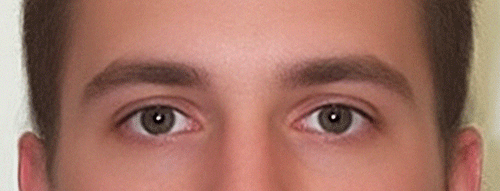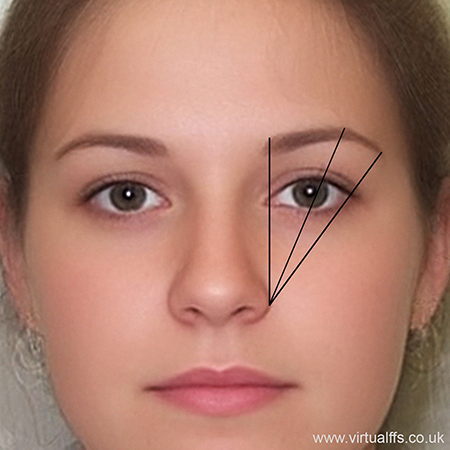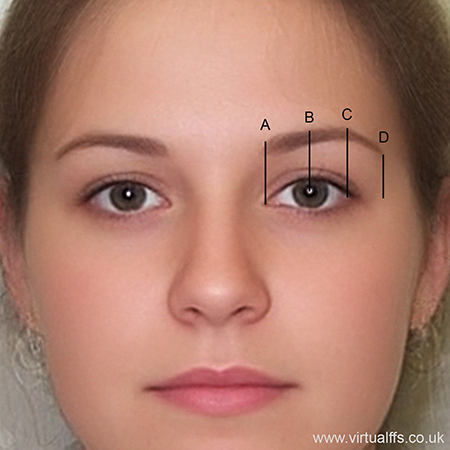Eyebrows
Gender Differences:
Women's eyebrows typically appear to sit in a higher position then men's but this is largely an illusion. In fact, the top edge of the eyebrows is in almost exactly the same place for men and women.
The reason female eyebrows appear to be higher is simply that they are thinner. Basically, if you remove the bottom half of a male eyebrow, it turns into a female eyebrow. The easiest way to see what I mean is to look at the animation below:

I don't know how much of the difference in thickness is natural, and how much is due to plucking. I suspect that at least some of it is natural but I have not seen any studies to confirm that yet. The gap between the eyebrows tends to be wider in females too, but that may also be down to plucking.
Many people think that woman have arched eyebrows while men have straight ones. This is also not really true, and there's a lot of variation from person to person, so some men and women have naturally arched brows, some have naturally straight brows, and there is every degree in between. Women tend to emphasise any natural arch they have by plucking (see below) but sometimes, when the eyebrows are very straight, there is not really any arch to emphasise.
Plucking:
Eyebrow plucking is actually one of the most powerfully feminising procedures and by far the least traumatic! It is often the first procedure I perform on a set of pictures when I am simulating FFS. Some people prefer thicker eyebrows or to leave them completely natural, and that's fine of course, but it's important to be aware that it can affect passability.
Personally, when it comes to plucking, I recommend that you go for a classic eyebrow shape rather than a fashion eyebrow shape. This is because eyebrows often do not fully grow back after they have been plucked a few times, and this can leave people with a fashion eyebrow shape long after the fashion has passed.
If you are not confident about plucking them yourself, you can get a professional beautician to do it for you. If you want to do it yourself, you may need and eyebrow plucking diagram as a guide. This is a popular one based on 3 imaginary lines that start from the edge of your nostril:

But there is a big problem with this diagram because people's nostrils vary quite a lot. This means that if your nostrils are wider or narrower than average, all the other measurements are thrown out.
Another problem would be if your nostrils are average but the distance between your eyes is not, for example, if your eyes are closer together or wider apart than average, the measurements are thrown out again. Having larger or smaller eyes than average will also throw the measurements out.
All these problems are caused by trying to anchor the eyebrow shape and position to the nose, so I have devised a new diagram that anchors the eyebrow to the eye itself and is therefore largely independent of things like your nose width or the distance between the eyes. It is based on the average female eyebrow which also happens to have the classic eyebrow shape. Here it is:

Here's how it works:
If you imagine a vertical line (A) rising from the inner corner of your eye, this tells you roughly where the inner end of the eyebrow should be.
Then imagine a vertical line rising from the centre of your pupil (B). This doesn't point to anything in particular, but it's halfway to the next line (C).
(C) rises from the outer corner of your eye, and this tells you roughly where the peak of the arch should be (but remember, not everyone has an arch to their eyebrows).
(A), (B) and (C) are equidistant and if you keep going the same distance again, you get the fourth line (D) which tells you where the end of the eyebrow should come.
Many diagrams suggest that the arch should be aligned with the outer edge of the iris rather than the outer corner of the eye but when you look at averaged pictures of women like the one I have used above, you can see that the arch is normally a little further out than that, and aligns with the outer corner.
Don't be too close to the mirror when you are making your measurements! You need to at least 3 feet away (1 metre) otherwise the measurements will be out. If you don't believe me, stand 3 feet away from the mirror, hold a pencil vertically against your face as if you were measuring line A, then gradually move closer to the mirror and see how the pencil moves out of alignment with the inner corner of your eye!
You can mark points along the eyebrow with an eyeliner when you are measuring, and to judge thickness I would say that the thickest part of the eyebrow should be about the thickness of a pencil for a classic eyebrow shape. And remember, you almost always pluck only the underside of the eyebrows (you generally only pluck along the top edge to remove the odd stray hair).
Having said all that, remember that everyone's eyebrows are different so only use plucking diagrams as a rough guide and don't try to force your eyebrows too far outside their natural shape.
Surgical Options for Brow Lifting:
1. Forehead Lift.
This technique can lift the eyebrows further than other techniques. It involves a long incision across the top of the head or along the hairline. A section of skin is removed and the forehead is pulled up to close the gap. The gap is then stitched shut. This means that the whole forehead is lifted. If the incision is made over the top of the head it is called a "coronal brow lift" and the advantage is that the scar will be invisible.
These are the same incisions that are used for forehead surgery so brow lifting and forehead surgery can be done at the same time.
Small plastic devices with backwards-pointing spines (endotines) can be used to anchor the eyebrows and soft tissues in place while everything heals. The endotines dissolve after a few months.
If you have a forehead lift with the incision behind the hairline then the hairline itself will also be raised when the gap is closed. This could be a problem if your hairline is already high but as I point out on the hairline page – women do actually tend to have higher hairlines than men, so in most cases raising the hairline a little is not be a problem and is often feminising.
If you wanted to avoid the hairline being raised, you would have to have the incision along the hairline rather than behind it. The problem with this approach is that it leaves a visible scar along the hairline like the one you can see on the Hair and Hairline page of this site.
2. Endoscopic Brow Lift.
In this technique, 3 to 5 small incisions are made in the scalp behind the hairline. The surgeon then uses instruments inserted through the incisions to lift the soft tissues away from the bone. Stitches are then used to pull up parts of the eyebrow. This technique is much more limited and can only achieve a more subtle lift.
Most FFS patients have forehead surgery, so they would be getting a subtle lift anyway because that's one of the effects of forehead surgery as I explained above. However, if you were not having forehead surgery and wanted a subtle lift, this technique might be useful.
3. Lateral Brow Lift
Also called a temporal brow lift this lifts the outer third of the eyebrow both upwards and outwards. The surgeon makes 2 incisions at the temples but behind the hairline where the scars won't show. A small amount of skin is removed and internal stitches hold everything in place.
4. Internal Brow Lift.
Also called a transblepharoplasty brow lift. This is performed at the same time as an upper blepharoplasty which is a procedure to remove excess skin from the upper eyelid. The eyebrow is accessed through the eyelid incision and is loosened from the underlying tissues. The eyebrow is then held in the new position with stitches or a small implant.
I have read about this procedure but have never met anyone who has had it. I suspect the effects would be subtle as it is effectively a type of endoscopic brow lift (see above).
5. Mid-Forehead Brow Lift.
In the mid-forehead brow lift, horizontal incisions are made in the middle of the forehead. This is likely to make the scars very noticeable and would usually only be performed when the patient has very strong horizontal frown lines that the surgeon can hide the scars in. I do not recommend this procedure,
I only include it here to be thorough.
6. Direct Brow Lift.
This is the simplest technique and involves cutting out a strip of skin along the top edge of the eyebrow and stitching the resulting gap closed to lift the eyebrow. This leaves a scar along the top of the eyebrow. I strongly recommend against this technique and have seen some very poor results with
very visible scarring.
Surgical Options for Changing the Shape of the Eyebrows:
You can usually change the shape a little with careful plucking but there are 2 additional options if you want to change the shape.
1. Botox.
Botox can be injected in various places around the eyebrows to
make different sections lift a little or drop a little and this can be
used to emphasise of de-emphasise an arch. It's subtle though.
2. Hair Transplants.
It is possible to have hair transplants to change the shape of your
eyebrows (or to make them more dense if they are very thin. The hair is
typically taken from the back of the head.
Some Questions:
Can you lower eyebrows?
You can't lower them surgically, however, in one severe case I came across
where a patient's eyebrows had been raised way too far, she had her
eyebrows removed with electrolysis and laser, and then had hair
transplants to create new eyebrows in the correct position.
If the problem is not so dramatic, you can sometimes lower them a little with careful plucking. This involves letting the underside of the eyebrow grow and then plucking along the top (usually eyebrows are plucked along the bottom) - essentially favouring the lower half of your eyebrow rather than the lower half. This can be an option as long as your eyebrows are naturally relatively thick so that you can remove hair from the top and still have enough brow left for it to look natural.
Some people shave off their eyebrows and do them with make-up. This technique allows you put them anywhere you like, but not everyone likes to wear make-up, and it requires good make-up skills as well as some dedication.
The "open expression" theory of eyebrows and eye size:
This is a theory I have developed after many years working on facial gender:
One of the things I noticed is that a mild brow lift seems to give a more feminine "open" expression to many faces, despite the fact that female eyebrows are not naturally higher than male eyebrows.
I believe there are two reasons for this:
1. As I described above, even though the top edge of male and female eyebrows is in the same place, there is a bigger gap between the eye and eyebrows on women because women's eyebrows are generally thinner. But higher eyebrows also increase the distance between the eye and eyebrows, so I think we perceive higher eyebrows as feminine at least partly because they mimic the effect of thin eyebrows.
2. The more "open" expression that women have is partly to do with the fact that women typically have larger eyes than men - basically, large eyes look more "open" than small eyes. But raising your eyebrows also opens your expression, and this means that a mild brow lift can have a similar effect on your expression as having larger eyes.
Now, it just so happens that eyebrows are lifted a little by forehead feminisation surgery. This is because when you remove bone from underneath the soft tissues, you need to take up the slack.
This kind of subtle brow lift of a few millimeters is fine - your eyebrows are taken to their new natural position and it has a gently feminising effect. The problem is that many surgeons still believe that women's eyebrows are much higher than men's and they lift the eyebrows of pretty much all their trans patients as much as they possibly can. This can put the eyebrows in a very unnatural position, and can leave the patient with a permanently "surprised" expression.
That doesn't mean that no one should have a strong brow lift - there are some people who can really benefit from one. These patients might have unusually low eyebrows to start with, or small eyes, or might be older patients with a lot of slack forehead soft tissue that has left the eyebrows sitting very low.
There are several ways of doing a stronger brow lift:
The Illusion of the Eyebrow Position on the Orbital Rim:
This is another theory I have developed over the years. It is often said that female eyebrows sit just above the orbital rim while male eyebrows sit on, or just below it. I would suggest that this is not really to do with eyebrow position but with the size of the orbital rims and the thinness of female eyebrows. Let me explain:
1. Given the same eyebrow position for men and women, the male eyebrow can still reach lower relative to the orbital rim because male eyebrows are twice the size of female eyebrows and all that extra eyebrow is along the underside of the male eyebrow. This makes it look like male eyebrows sit on or even below the rim.
2. On females, the orbital rim is typically just the point at which the forehead meets the eye socket, but men often have a large ridge of bone along the rim. This ridge can extend above the eyebrows and can therefore give the impression that the eyebrow is sitting low relative to the rim.
To sum up: once you remove the male bossing along the orbital rim and pluck the underside of the eyebrow, you find that the eyebrow was not sitting lower after all - it just seemed that way because it was thick and was sitting on a large ridge.
An Interesting Observation:
I have noticed that most people's left eyebrow is slightly higher than the right. I have absolutely no idea why that would be but it's remarkably consistent. For example, you can see it in the pictures on this page which were created by averaging several faces together. I don't know whether this is a new observation but I have not seen it mentioned in any studies.